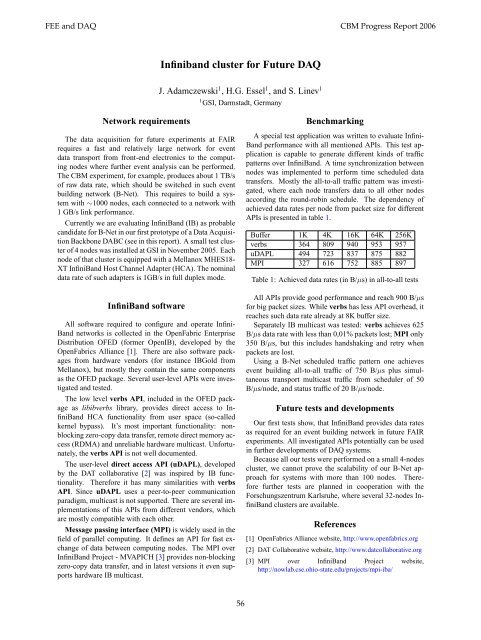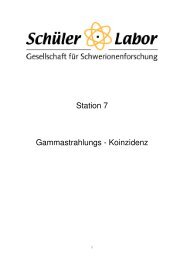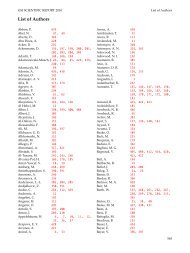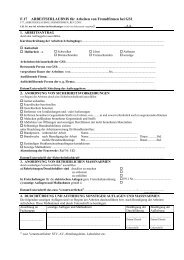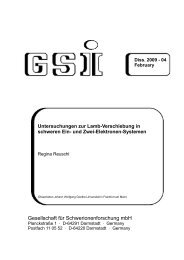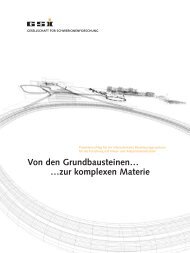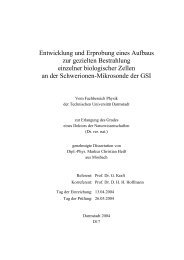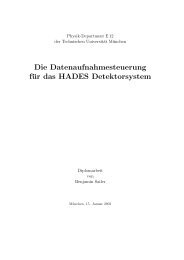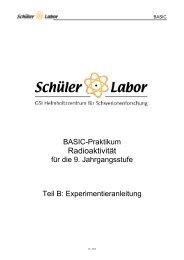CBM Progress Report 2006 - GSI
CBM Progress Report 2006 - GSI
CBM Progress Report 2006 - GSI
Create successful ePaper yourself
Turn your PDF publications into a flip-book with our unique Google optimized e-Paper software.
FEE and DAQ <strong>CBM</strong> <strong>Progress</strong> <strong>Report</strong> <strong>2006</strong><br />
Network requirements<br />
The data acquisition for future experiments at FAIR<br />
requires a fast and relatively large network for event<br />
data transport from front-end electronics to the computing<br />
nodes where further event analysis can be performed.<br />
The <strong>CBM</strong> experiment, for example, produces about 1 TB/s<br />
of raw data rate, which should be switched in such event<br />
building network (B-Net). This requires to build a system<br />
with∼1000 nodes, each connected to a network with<br />
1 GB/s link performance.<br />
Currently we are evaluating InfiniBand (IB) as probable<br />
candidate for B-Net in our first prototype of a Data Acquisition<br />
Backbone DABC (see in this report). A small test cluster<br />
of 4 nodes was installed at <strong>GSI</strong> in November 2005. Each<br />
node of that cluster is equipped with a Mellanox MHES18-<br />
XT InfiniBand Host Channel Adapter (HCA). The nominal<br />
data rate of such adapters is 1GB/s in full duplex mode.<br />
InfiniBand software<br />
All software required to configure and operate Infini-<br />
Band networks is collected in the OpenFabric Enterprise<br />
Distribution OFED (former OpenIB), developed by the<br />
OpenFabrics Alliance [1]. There are also software packages<br />
from hardware vendors (for instance IBGold from<br />
Mellanox), but mostly they contain the same components<br />
as the OFED package. Several user-level APIs were investigated<br />
and tested.<br />
The low level verbs API, included in the OFED package<br />
as libibverbs library, provides direct access to InfiniBand<br />
HCA functionality from user space (so-called<br />
kernel bypass). It’s most important functionality: nonblocking<br />
zero-copy data transfer, remote direct memory access<br />
(RDMA) and unreliable hardware multicast. Unfortunately,<br />
the verbs API is not well documented.<br />
The user-level direct access API (uDAPL), developed<br />
by the DAT collaborative [2] was inspired by IB functionality.<br />
Therefore it has many similarities with verbs<br />
API. Since uDAPL uses a peer-to-peer communication<br />
paradigm, multicast is not supported. There are several implementations<br />
of this APIs from different vendors, which<br />
are mostly compatible with each other.<br />
Message passing interface (MPI) is widely used in the<br />
field of parallel computing. It defines an API for fast exchange<br />
of data between computing nodes. The MPI over<br />
InfiniBand Project - MVAPICH [3] provides non-blocking<br />
zero-copy data transfer, and in latest versions it even supports<br />
hardware IB multicast.<br />
Infiniband cluster for Future DAQ<br />
J. Adamczewski 1 , H.G. Essel 1 , and S. Linev 1<br />
1 <strong>GSI</strong>, Darmstadt, Germany<br />
56<br />
Benchmarking<br />
A special test application was written to evaluate Infini-<br />
Band performance with all mentioned APIs. This test application<br />
is capable to generate different kinds of traffic<br />
patterns over InfiniBand. A time synchronization between<br />
nodes was implemented to perform time scheduled data<br />
transfers. Mostly the all-to-all traffic pattern was investigated,<br />
where each node transfers data to all other nodes<br />
according the round-robin schedule. The dependency of<br />
achieved data rates per node from packet size for different<br />
APIs is presented in table 1.<br />
Buffer 1K 4K 16K 64K 256K<br />
verbs 364 809 940 953 957<br />
uDAPL 494 723 837 875 882<br />
MPI 327 616 752 885 897<br />
Table 1: Achieved data rates (in B/µs) in all-to-all tests<br />
All APIs provide good performance and reach 900 B/µs<br />
for big packet sizes. While verbs has less API overhead, it<br />
reaches such data rate already at 8K buffer size.<br />
Separately IB multicast was tested: verbs achieves 625<br />
B/µs data rate with less than 0,01% packets lost; MPI only<br />
350 B/µs, but this includes handshaking and retry when<br />
packets are lost.<br />
Using a B-Net scheduled traffic pattern one achieves<br />
event building all-to-all traffic of 750 B/µs plus simultaneous<br />
transport multicast traffic from scheduler of 50<br />
B/µs/node, and status traffic of 20 B/µs/node.<br />
Future tests and developments<br />
Our first tests show, that InfiniBand provides data rates<br />
as required for an event building network in future FAIR<br />
experiments. All investigated APIs potentially can be used<br />
in further developments of DAQ systems.<br />
Because all our tests were performed on a small 4-nodes<br />
cluster, we cannot prove the scalability of our B-Net approach<br />
for systems with more than 100 nodes. Therefore<br />
further tests are planned in cooperation with the<br />
Forschungszentrum Karlsruhe, where several 32-nodes InfiniBand<br />
clusters are available.<br />
References<br />
[1] OpenFabrics Alliance website, http://www.openfabrics.org<br />
[2] DAT Collaborative website, http://www.datcollaborative.org<br />
[3] MPI over InfiniBand Project website,<br />
http://nowlab.cse.ohio-state.edu/projects/mpi-iba/


